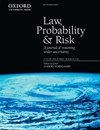利用包装重量推断一次均质零售毒品缉获的重量
IF 2.7
4区 社会学
Q1 LAW
引用次数: 1
摘要
我们提出了一种方法,该方法产生了因缉获邮袋而产生的毒品粉末净重的概率分布。该技术涉及在共轭先验下β分布的后验预测分布。对同一缉获的两组视觉上不同的邮袋计算两个分布的卷积。本文章由计算机程序翻译,如有差异,请以英文原文为准。
Extrapolating the weight of a homogeneous retail drug seizure using packing weight
We propose a method that yields a probability distribution for the net weight of drug powder resulting from a seizure of stamp bags. The technique involves the posterior predictive distribution of a beta distribution under a conjugate prior. The convolution of two distributions is computed for two visually distinct groups of stamp bags from the same seizure.
求助全文
通过发布文献求助,成功后即可免费获取论文全文。
去求助
来源期刊

Law Probability & Risk
MATHEMATICSSTATISTICS & PROBABILITY&-STATISTICS & PROBABILITY
CiteScore
2.10
自引率
28.60%
发文量
8
期刊介绍:
Law, Probability & Risk is a fully refereed journal which publishes papers dealing with topics on the interface of law and probabilistic reasoning. These are interpreted broadly to include aspects relevant to the interpretation of scientific evidence, the assessment of uncertainty and the assessment of risk. The readership includes academic lawyers, mathematicians, statisticians and social scientists with interests in quantitative reasoning.
The primary objective of the journal is to cover issues in law, which have a scientific element, with an emphasis on statistical and probabilistic issues and the assessment of risk.
Examples of topics which may be covered include communications law, computers and the law, environmental law, law and medicine, regulatory law for science and technology, identification problems (such as DNA but including other materials), sampling issues (drugs, computer pornography, fraud), offender profiling, credit scoring, risk assessment, the role of statistics and probability in drafting legislation, the assessment of competing theories of evidence (possibly with a view to forming an optimal combination of them). In addition, a whole new area is emerging in the application of computers to medicine and other safety-critical areas. New legislation is required to define the responsibility of computer experts who develop software for tackling these safety-critical problems.
 求助内容:
求助内容: 应助结果提醒方式:
应助结果提醒方式:


